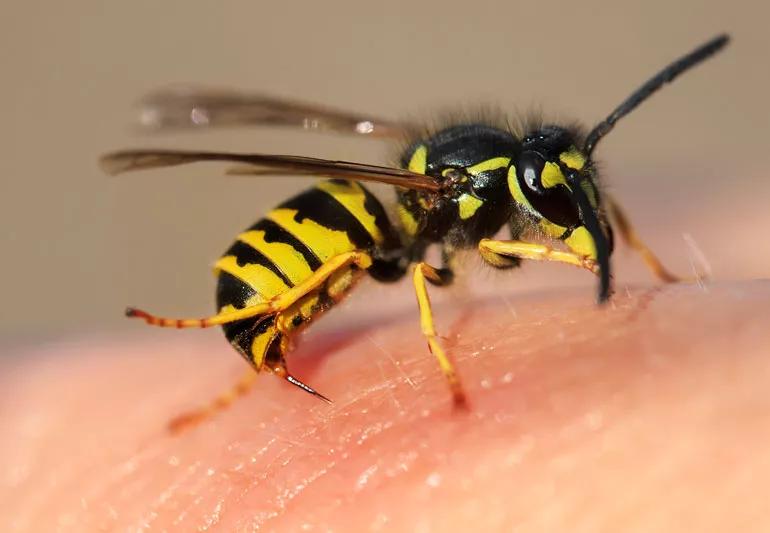If stung, removing the stinger quickly is key — then, apply a cold compress to soothe

Nothing ruins an outdoor barbecue faster than the shout of “Bee!” followed by friends and family screaming and running for cover. And if you’ve ever been stung by a bee or wasp, you know there’s good reason to protect yourself from these flying insects.
Advertisement
Cleveland Clinic is a non-profit academic medical center. Advertising on our site helps support our mission. We do not endorse non-Cleveland Clinic products or services. Policy
So, what should you do if you’ve been stung?
Emergency medicine specialist Baruch Fertel, MD, talks with us about how to deal with bee, wasp and hornet stings — plus how you might prevent them in the future.
No matter what stung you, you’re likely to feel some pain, throbbing and stinging, along with redness in the affected area. Unless you have an allergic reaction, these symptoms shouldn’t stick around for too long.
“Redness and swelling at the site of the sting is a normal reaction and will subside over time, usually in one to two days,” says Dr. Fertel. In terms of treatment, bee, wasp and hornet stings can be treated the same — unless the person has a specific allergy.
Here are a couple of things to know in terms of how bees, wasps and hornets differ:
Bees
Advertisement
Wasps
Hornets
Sometimes, even when you do everything right, you can still get stung. Take these steps immediately following an insect sting:
You may have heard that you should swipe the stinger out with a credit card or your fingernail rather than pinching and pulling it out. But, says Dr. Fertel, there’s no evidence that the technique makes a difference. What does matter is how quickly you remove the stinger. So, don’t stress about how it’s done — just get it over with fast. This is because the quicker you’re able to remove the stinger, the less venom will be pumped into the wound. This will help decrease the side effects of the sting and reduce the risk for anaphylactic shock if you’re allergic.
The next step is to apply a cold compress to the affected area. You can use an ice pack covered in a towel or a bag of frozen produce. Hold the cold compress on the area for about 20 minutes and elevate the area to help reduce swelling.
“I would encourage washing the area with soap and water and soaking if possible,” says Dr. Fertel. “It can reduce swelling or risk of infection.”
If you’re experiencing some swelling or itching, taking an antihistamine can help, too. You can also take a pain reliever like ibuprofen to help reduce any discomfort.
Getting stung by a bee, wasp or hornet is no fun — but no one wants to cancel their summer plans because of the risk. So, instead, take the proper measures to help prevent these stings from happening in the first place.
Advertisement
The top culprit that brings any kind of insects to your yard is food. And it’s not just dessert they’re after — they also eat protein (looking at you, fried chicken!), so don’t overlook any snacks you may have outside.
To keep bugs away:
Even if there isn’t any food around you, there may be another cause to why bees are flocking to you. Flowery or fruity-scented products like lotions, perfumes and hair care attract insects who are searching for their next bit of nectar. Leave these products out of your routine on days you’re headed to a picnic or barbeque.
Your clothing is your last line of defense against stinging insects. That means, if you want to avoid bees, wear long sleeves, pants and closed-toed shoes to keep bugs from landing on your skin.
Bright colors may also create buzz among bees and wasps. Red is safe, as bees don’t see this color. But bees do notice the rest of the rainbow and are especially drawn to purple, violet and blue.
Despite your efforts, you may still come across a bee or two, especially if you’re out in nature for a while. The big rule here is not to panic because it will just make things worse. Waving your arms and causing a big ruckus won’t help, stresses Dr. Fertel. And the commotion could increase the risk of getting stung. Instead, hold still and wait until the insect goes away.
Advertisement
And if you have a severe allergy to insect stings, keep a prescribed epinephrine autoinjector on you at all times, Dr. Fertel advises, especially when outdoors.
For some people, a sting can cause anaphylaxis, a severe, life-threatening allergic reaction throughout your body. Anyone could experience anaphylaxis, but those with allergies and asthma are at higher risk.
If you or someone nearby starts showing symptoms of anaphylaxis, go to a doctor or call 911. Anaphylaxis is an emergency. It includes these symptoms in response to an insect sting:
Remember, for most people, an insect sting is a temporary, treatable discomfort. By following some simple guidelines outdoors, you can usually prevent bee, wasp and hornet stings. And if you want to be truly safe when you host your next patio party — set up the buffet inside.
Advertisement
Learn more about our editorial process.
Advertisement

Bleeding is a risk and warrants taking care, but the reward of this lifesaving medication is great

Severe and debilitating headaches can affect the quality of your child’s life

With repeat injections over time, you may be able to slow the development of new wrinkles

Although it can be alarming, it’s normal to experience blood clots during menstruation

Stretch before heading outside, keep proper form and avoid jerking or twisting to throw snow

Type 2 diabetes isn’t inevitable with these dietary changes

Applying a hot or cold compress can help with pain